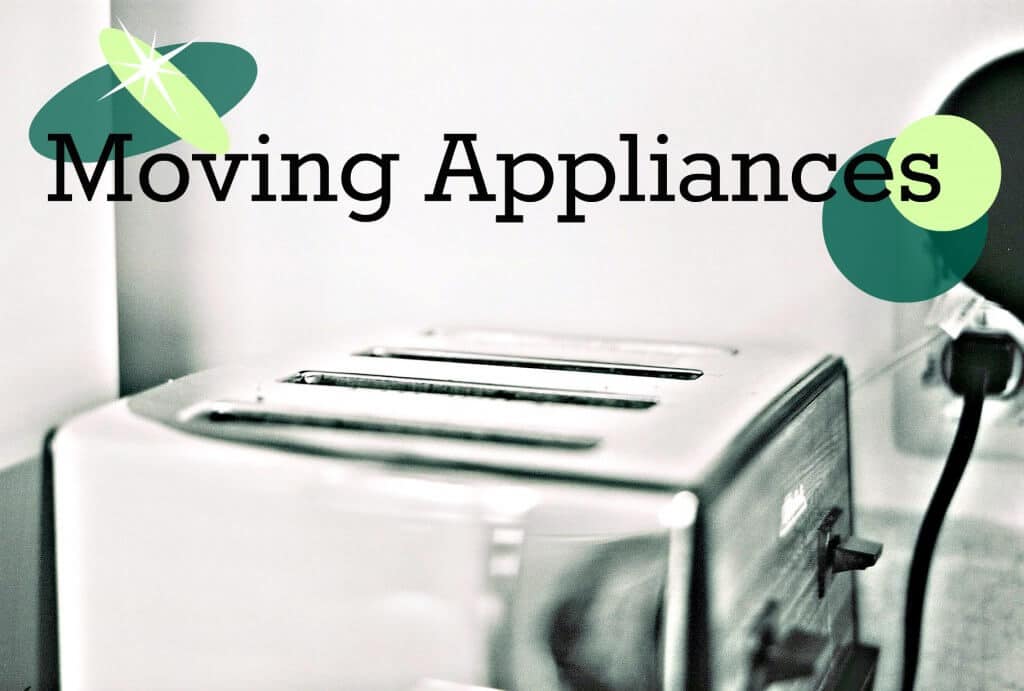Moving Appliances

Whether it’s your washer/dryer, your heavy-duty gas range, or just the microwave, moving appliances calls for some very specific steps to ensure that all the machinery is in perfect working order at your new house or apartment.
Before you unplug anything, make sure you have taken all necessary precautions for moving appliances—big or small.
Washer/Dryer
As with all appliances, make sure your washing machine is clean and dry, otherwise mildew and mold can grow.
Disconnect the hoses and drain them completely of water. Wrap any metal ends of the hoses in a towel or other padding and place them inside the washer tub. Then, secure the tub to keep it from bumping around during transit. The operating manual will probably have instructions for tightening the screws on the tub, but if you don’t have instructions, you can purchase a kit at your local hardware store.
When moving your dryer, clean the lint trap before unplugging the cord. Also, be sure to check the outlets in your new place, to make sure your dryer has the appropriate plug. Dryer plugs come in three- and four-prong versions, and your dryer cord may not match the socket at your new place. If this is the case, don’t worry, it’s an easy fix to replace your cord.
If you are moving a gas dryer, hire a professional appliance technician (not one of your moving crew) to disconnect and cap off the gas lines. You don’t want to take any chances with gas leaks.
Dishwasher
Again, disconnect and drain all hoses and make sure the inside of your dishwasher is clean and dry before you move it. It’s also a good idea to leave the door ajar for a few days before you move (while you eat from disposable plates) to make sure the interior is completely dry. Once you know the hoses are no longer wet, wrap them in a towel and/or crushed paper and place inside the unit for transport.
Stove/Oven
Make sure the unit is completely clean of all grease and crumbs, as the grease will attract dust and potentially leave stains. If there are any loose parts (electrical coils or grates), remove them and pack separately in a well-cushioned box. If you have a gas-powered range, make sure it is disconnected, moved, and re-connected by a qualified technician.
Fridge
If you are taking your fridge to your new home, you will need to dispose of or use all perishables in your fridge at least a week before the move.
Refrigerator interiors are airtight, so you will need to make sure they are bone-dry before you shut them up (especially for long-distance moves). A small amount of moisture can cause mold and mildew to run rampant. Unplug the machine, then remove and clean all interior shelves and baskets. Once all moisture has evaporated, pack in a separate box.
Pull your fridge out from the wall recess and vacuum the coils and compressor in the back. Next, empty and clean the evaporator pan, giving it plenty of time to dry. If your fridge has a water/ice hookup, turn off and disconnect all water lines and empty out the water reservoir.
After your move, make sure all hoses are connected by a professional and wait at least 24 hours before you use your fridge. This will allow the oil to settle, preventing damage to the compressor. Once the water dispenser and icemaker have been hooked up properly, dispose of the first few batches of ice and a couple large pitchers of water. This will remove any impurities that may have found their way into the lines.
Microwave
Luckily, your microwave is not as complicated to move. Simply remove any breakable parts—such as the glass shelf—and wrap with a towel before stowing in a sturdy box. Pack the microwave in an appropriately sized box and cushion well, but be sure that nothing is in a position to spring open the door during the move.
If you have a very large unit, you can ask your moving company to simply quilt-pad it and put it on the truck.
Hand-held Appliances
Items like curling irons, hair dryers, and clock radios require no special preparation before moving. Just wrap the cords securely, wrap and cushion the object with crushed paper, and place in a box. (Irons should be emptied of all water first.)
Make sure any boxes containing electrical equipment are labeled with their contents. You don’t want to risk anything getting wet during transport. You may even want to pack them in watertight plastic bins for extra security.
Even if you have decided not to hire an Orlando moving company to move your furniture and other belongings, you may want to consider hiring a professional company to move your appliances, especially if there are a lot of them. Bulky, delicate equipment can be easily damaged during a move if you don’t have the knowledge and experience. Ask Cento Family Moving & Storage before your move for the specific steps necessary for moving your appliances.
Recent Posts
- The Ultimate Guide to Packing Office Equipment April 12, 2024
- How to Find a Reliable Mover (and Avoid Scams!) April 5, 2024
- How Much Does It Cost To Move (Without a Moving Company)? March 13, 2024








Comments are closed.